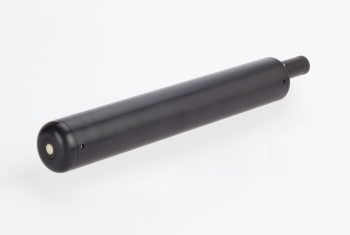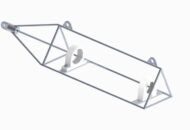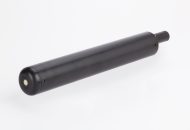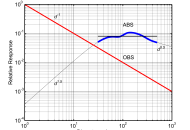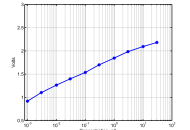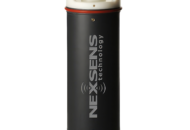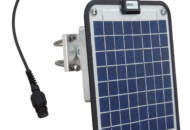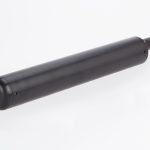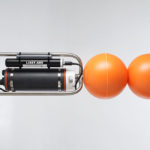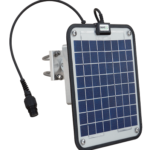FAQ
Why a new sediment sensor?
The LISST-ABS is designed as a replacement to optical turbidity sensors. Optical turbidity loses sensitivity (V/concentration) as grain size increases. The 8MHz LISST-ABS has nearly constant sensitivity from ~30-450 microns. See Application Note.
How does the LISST-ABS work
The LISST-ABS sends a short pulse of 8MHz sound into water. It listens for backscattered echo from two points. The first point is the sample volume. This is the acoustic signal strength. The second point serves to estimate attenuation by sediments (see next FAQ on how). When attenuation is significant, a correction is applied to the signal strength from the sample volume.
How is attenuation measured, and attenuation correction applied?
Note from last FAQ, that backscatter signals are measured from 2 points. The difference between them is due to spreading of acoustic beam, and attenuation by water and sediment. At low concentrations of sediments (say pure water), the difference is solely due to geometric spreading and water attenuation. This is fixed (see other FAQ for why temperature effect on water attenuation can be ignored). If a measured difference exceeds this fixed value, the excess is assigned to sediment attenuation. This is sediment attenuation. An attenuation correction is then applied to the backscatter from the sample volume (first point). The correction equals the attenuation per unit distance times the distance of sample volume to transducer.
Why is change in water temperature unimportant?
It’s because the in-water path is short, just 5 cm. Water attenuation is already very small at such short distance. The changes in water attenuation due to temperature are even smaller, hence insignificant. Attenuation in water at 8MHz is about 1dB/m, or 0.05dB for our sample volume. The change in attenuation with temperature is even an order of magnitude smaller, hence, smaller than our accuracy and therefore, insignificant.
How about change in location of sample volume due to change in water temperature?
The change in speed of water with temperature is about 0.23%/deg-C. This means that a 10-deg-C change would affect the location of the sample volume by 2.3%, or 0.023*5 cm, i.e. 0.15cm. Too small compared to the 5cm distance from the transducer.
How is LISST-ABS better than optical turbidity sensors?
Optical turbidity sensors lose sensitivity (Volts/Concentration) as 1/diameter for particles larger than about 1 micron. LISST-ABS, due to its 8MHz choice, gains sensitivity from 1 to ~30 microns, but then is more or less constant out to about 450 microns, so that it sees coarse grains well, which turbidity misses. See for more…
How is LISST-ABS a better sediment sensor than an ADCP?
- The LISST-ABS is designed to measure sediments, unlike ADCP. Care is taken to ensure constant transmitted acoustic power, and stable electronics.
- The measurement volume is a short distance away from the transducer (5cm). Consequently, changes in water temperature or sound velocity are not significant, unilke ADCP (see FAQ’s above).
- The LISST-ABS uses 8MHz frequency which significantly flattens its sensitivity [V/(mg/L)] to particles in ~30-450 micron range.
- LISST-ABS measures attenuation due to sediment, and corrects for it.
Why is LISST-ABS less susceptible to bio-fouling?
The acoustic vibration of the sensor face discourages biological growth. Also, a small amount of biological growth on the sensor does not affect performance significantly.
What range of particle sizes does the LISST-ABS measure?
There is no size cut-off on either the small or large size end. However, the LISST-ABS measures particles in the 30-400 micron range far better than turbidity or ADCP sensors. The plot below shows the response of the LISST-ABS as a function of grain size, contrasted with turbidity sensor, OBS.
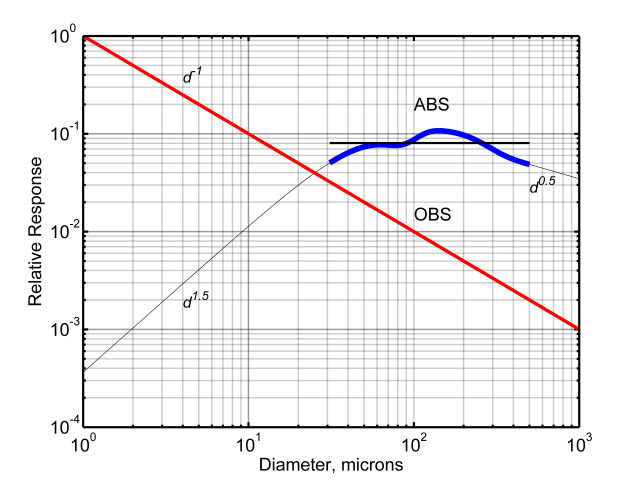
Is acoustic sensitivity, like optical turbidity, grain size dependent?
Yes. Details are offered here. In the Rayleigh region (particles smaller than acoustic wavelength), sensitivity changes with size, but in an opposite way from optics. Whereas optical turbidity sensors lose sensitivity for increasing grain size, acoustic sensitivity increases, till flattening out at around 30 microns for our chosen 8MHz frequency. For more…
What range of sediment concentration does the LISST-ABS measure?
Roughly from 1mg/L to 30g/L, depending on particle size.
For broad sediment size distributions, how do OBS and LISST-ABS compare?
This question is answered in an application note. 8MHz Acoustics of the LISST-ABS produce a superior sensor by way of response to broad size distributions. For more…
Why is the measurement volume at a short and fixed range?
By choosing a short range, attenuation by water becomes less important. Furthermore, changes in water temperature, which produce changes in attenuation property, also become insignificant.
Can I plug the LISST-ABS into my CTD?
The LISST-ABS requires 12-volts to operate and outputs attenuation corrected backscatter via analog, RS232, and/or SDI-12. Input power and all three outputs are supplied via a single 8 pin connector. The three different signal outputs and single connector make the LISST-ABS compatible with most systems.
Are individual LISST-ABSs interchangeable, with equal calibrations?
Yes, their response is equalized at factory for interchangeability.
What calibration process must I use in order to measure mass concentrations?
The calibration requires measuring LISST-ABS output for one fixed sediment concentration. We provide a procedure to automatically convert the measurement to calibration factors.
How is LISST-ABS data converted to sediment concentration?
The ABS digital outputs are in Uncalibrated Concentration (UC) units. To convert UC to calibrated concentration, multiply UC by a coefficient determined by measurement of a known concentration. The LISST-ABS software provides a simple procedure for measuring the coefficient.
What if I forget to calibrate my LISST-ABS before use?
If you save the raw data sent from the LISST-ABS, you can always apply a corrected calibration later.
Can LISST-ABS measure attenuation in water?
The LISST-ABS measures sediment attenuation but only at high sediment concentration values. It is not recommended as an attenuation measuring device at sediment concentrations below several g/L.
How does attenuation coefficient of particles vary with grain size?
There is a simple formula published by Thorne and Hanes (2002): A review of acoustic measurement of small-scale sediment processes. Continental Shelf Research 22: 603-632.
doi:10.1016/S0278-4343(01)00101-7
What causes fluctuations in output of LISST-ABS
There are two factors that contribute to a noise-like fluctuation in the output of the LISST-ABS. The first is Rayleigh statistics of scattering due to the random positions of particles in the acoustic sample volume, and the second is real fluctuations in sediment concentration. The first cannot be avoided, it can be managed by adequate averaging; the second is part of the measurement, and should be treated as signal, not noise.
The LISST-ABS manages Rayleigh noise by averaging a large number of pings (1,000) each second. If particles move about a wavelength between pings, then successive signal strengths become statistically independent, and noise is reduced by the square root of number of pings. If they move less, the noise reduction is less also as successive samples are not statistically independent. Since the sound wavelength at 8MHz is ~0.2mm, full benefit of a 1,000 pings happens at velocities about 20cm/s or higher.
As for turbulent fluctuations of sediment concentration, these are, of course, signal. Such fluctuations occur in nature almost everywhere – from laboratory mixing chambers to rivers and seas. So, don’t be distressed to see fluctuations in your 1Hz data.
How does particle scattering coefficient vary with grain size for LISST-ABS?
The scattering coefficient can be calculate by a formula provided by Thorne and Hanes2002, see citation above.
Is the ABS measurement degraded by unknown attenuation?
No. The instrument measures the in-situ attenuation and applies a correction to produce the ACB.
Does the near-field effect affect calibration?
The backscattering signal strength from two range-bins differs by the attenuation between them – geometric and water absorption. Thus, near-field effects, which are geometrical, cancel out.
How is attenuation measured and compensated?
Attenuation is measured from the difference in backscatter strength from two adjacent range bins. This measured attenuation is the sum of contributions from beam-spread, water absorption, and sediment scattering. The first two factors remain dominant at low sediment concentrations. Their combined attenuation is measured in low sediment concentration tests, and is stored. When attenuation measured in field data exceeds this value, that is attributed to sediment attenuation. The stored Attenuation Corrected Backscatter (ACB) is de-attenuated for both these effects.
Why is LISST-ABS called a LISST?
LISST was originally an acronym for our laser particle sizing sensors. LISST now is just a Sequoia trade name. So, we carried it into acoustics.
What is ACB? How is it measured?
ACB stands for attenuation corrected backscatter. As explained above, attenuation is estimated in situ for each sample. The raw acoustic signals are then compensated for this attenuation, producing ACB.
What is the size of sample volume?
The sensor volume is approx. 4 cm long x 5mm in diameter.
Which sound velocity is used? Fresh or saltwater?
We use sound velocity in salt water. People ask these questions because they are thinking of long-range ADCP where changes in sound velocity affect the location of cells. For example, a 1% change in sound velocity would displace a measurement volume that was earlier at 100m to 101 m. Since our measurement volume is so close to the sensor, the change in location is proportionally small, and negligible. It is also not the dominant cause of fluctuations in signal strength (which is due to variable numbers of particles in the sample volume at different pings; the pings are 1msec apart, and 1000 pings are averaged.)
What cable lengths can I use with the LISST-ABS?
The ABS will operate over a 100m cable that Sequoia provides, powered by a USB port, using the standard USB adapter supplied by Sequoia. We can guarantee operation over a 100m Sequoia-built cable for USB connection or RS232 interface.
SDI-12 can potentially go a lot longer than 100 meters (perhaps 200 or more), but the limit depends on details that are out of Sequoia’s control, such as the power source in your system.
Can I rent the LISST-ABS?
